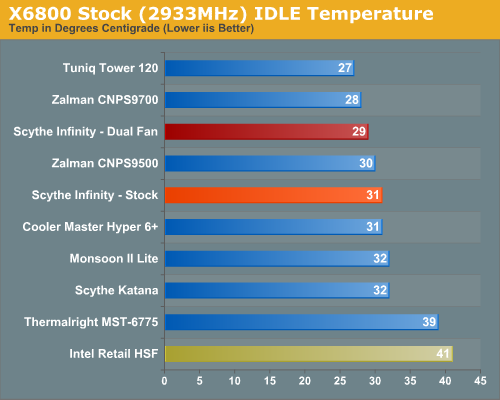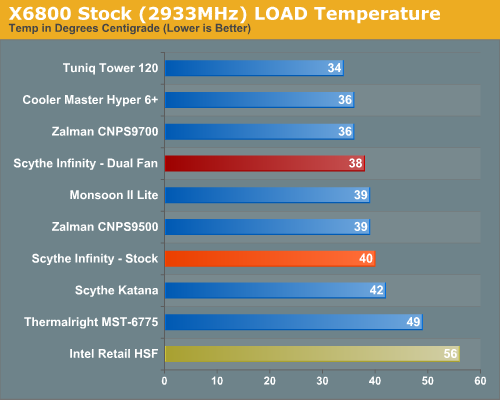Scythe Infinity: 5 Heatpipes and Silent 120mm Fan
by Wesley Fink on February 26, 2007 12:05 AM EST- Posted in
- Cases/Cooling/PSUs
Cooling at Stock Speed
Some users will never overclock their CPU, but they still want to run the coolest CPU temperatures possible to enhance stability and extend CPU life. In this review two new graphs have been added to the test results, so that readers can better compare idle and load performance of the tested coolers at stock X6800 speed of 2.93GHz.

The Scythe Infinity is an excellent performer in CPU cooling at stock speeds. However, when a second cooling fan is added in a push-pull arrangement the cooling gets even better. Stock IDLE cooling is average among the tested coolers with the stock one fan, but a second fan moves the Infinity up as a top performer.
Where the very good Intel stock cooler keeps the X6800 at 41C at idle, the Infinity can manage an excellent 31C/29C, with the stock/dual fans. The push-pull fan setup lands the Infinity in the same ball park with the 27C of the Tuniq Tower and the 28C of the Zalman 9700. These three coolers are the only ones to cool below 30C in our IDLE tests.
It is more difficult to effectively simulate a computer being stressed by all of the conditions it might be exposed to in different operating environments. For most home users CPU power is most taxed with contemporary gaming. Therefore our stress test simulates running a demanding contemporary game.
The Far Cry River demo is looped for 30 minutes and the CPU temperature is captured at 4 second intervals with the NVIDIA monitor "logging" option. The highest temperature during the stress test is then reported. Momentary spikes are ignored, as we report a sustained high-level temp that you would expect to find in this recording configuration.

The stock Infinity was below average under load testing at stock speeds, managing 40C under load compared to the Tuniq 34C and the Cooler Master Hyper 6+ and Zalman 9700 at 36C. Adding the second fan again dropped temperature and improved cooling to 38C for the Infinity dual, which was a better performance.
Some users will never overclock their CPU, but they still want to run the coolest CPU temperatures possible to enhance stability and extend CPU life. In this review two new graphs have been added to the test results, so that readers can better compare idle and load performance of the tested coolers at stock X6800 speed of 2.93GHz.

The Scythe Infinity is an excellent performer in CPU cooling at stock speeds. However, when a second cooling fan is added in a push-pull arrangement the cooling gets even better. Stock IDLE cooling is average among the tested coolers with the stock one fan, but a second fan moves the Infinity up as a top performer.
Where the very good Intel stock cooler keeps the X6800 at 41C at idle, the Infinity can manage an excellent 31C/29C, with the stock/dual fans. The push-pull fan setup lands the Infinity in the same ball park with the 27C of the Tuniq Tower and the 28C of the Zalman 9700. These three coolers are the only ones to cool below 30C in our IDLE tests.
It is more difficult to effectively simulate a computer being stressed by all of the conditions it might be exposed to in different operating environments. For most home users CPU power is most taxed with contemporary gaming. Therefore our stress test simulates running a demanding contemporary game.
The Far Cry River demo is looped for 30 minutes and the CPU temperature is captured at 4 second intervals with the NVIDIA monitor "logging" option. The highest temperature during the stress test is then reported. Momentary spikes are ignored, as we report a sustained high-level temp that you would expect to find in this recording configuration.

The stock Infinity was below average under load testing at stock speeds, managing 40C under load compared to the Tuniq 34C and the Cooler Master Hyper 6+ and Zalman 9700 at 36C. Adding the second fan again dropped temperature and improved cooling to 38C for the Infinity dual, which was a better performance.










39 Comments
View All Comments
dtanner - Monday, February 26, 2007 - link
By keeping the tower short, you are keeping the mass of the tower closer to the mobo and thus reducing the stress on the push pins. As another poster has stated, with this much mass I would definitely spend the extra $10 and get the UNIVERSAL RETENTION KIT "SCURK1".chienpourri - Monday, February 26, 2007 - link
Juste a suggestion, Scyte sells a UNIVERSAL RETENTION KIT "SCURK1" that anyone can find for around 10$, it comes with a backplate and everything. As the reviewer said, I would feel very uncomfy sitting the Infinity with only brackets... However using this kit it would fix the problem. The only downside I can find is the increased cost, but 10$ for security sounds good to me!orion23 - Monday, February 26, 2007 - link
Yeah...That!orion23 - Monday, February 26, 2007 - link
Hi!Great test guys!
I love how Anandtech started testing and reviewing other PC components.
You guys are doing great so far! Keep them coming...
And don't forget Power Supply Units!
Calin - Monday, February 26, 2007 - link
I find it somewhat to be understood - as the air would flow worse inside the cooler, part of it will flow out of it using the lateral spaces - as such, contributing very little or not at all to cooling.I wonder how much would single fan cooling improve if the air flow would be restricted in escaping by the sides. If so, what the performance would be with a push-pull configuration and lateral restrictions on air movement (escape)?
Jjoshua2 - Monday, February 26, 2007 - link
What I want to see is a more head to head test, with either the Tuniq using fans at the Infinity noise level, or the Infinity getting two higher powered fans, to see which wins.What I am interested in is the best performing silent/near silent fan & heatsink combo.
But overall, I liked the article thanks!
Wesley Fink - Monday, February 26, 2007 - link
We appreciate your suggestion, but we make every effort to test CPU coolers as they are packaged if at all possible. It would be a massive effort to try to go through an assortment of fans, find those singles and pairs that noise match and then replace fans supplied with the coolers with these matched singles and pairs. HSFs like Zalman have embedded fans which can't be swapped, and many top coolers use fan sizes with more limited selections than the 92mm or 120mm fan sizes.You have an interesting idea for an article on silent cooling, but it does go beyond the bounds of benchmarking and comparing performance of CPU coolers.
crimson117 - Monday, February 26, 2007 - link
What is the ambient temperature in the room during testing?Does the room get hotter after a few hours of testing, perhaps skewing temperatures higher for models tested at the end of the day?
Wesley Fink - Monday, February 26, 2007 - link
The ambient temperature of the room is 69F (21C) and is reasonably consistent. When running many computers in benchmarking the temperature may rise to 75F, but we check the temperature and turn off other systems during cooler testing.